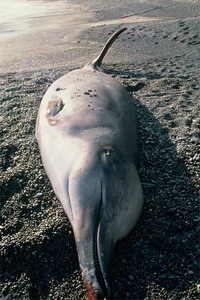Navy sonar has wrecking effect upon beaked whales in Pacific
Research team members are searching for rarely seen beaked whales.

The small, gray marine mammals have been at the center of the dispute over the Navy's use of high intensity sonar ever since several washed ashore with bleeding around their brains and ears during naval exercises in the Bahamas seven years ago.
"They appear to be the most susceptible group of cetaceans to impacts from Navy sonars," said Baird, a marine biologist based in Olympia, Washington, whose team recently spent three weeks off Hawaii's Big Island studying whales.
Training sailors to use sonar is a top priority for the Navy as more nations, including China, have acquired quiet, hard-to-detect submarines. In many cases, the only way the Navy can find these stealthy ships is by using mid-frequency active sonar, firing bursts of sound through the water and listening for an echo off a ship's hull.
Environmentalists have filed lawsuits challenging the Navy's plans for sonar training exercises, claiming the underwater noise harms whales and arguing there is enough evidence to require the Navy to take more aggressive measures to protect the animals.
The Navy says it does not want to deny its sailors the full spectrum of sonar training because of unproven theories.
Beaked whales are among the least understood marine mammals. To learn more, Baird's research team headed off the Kona coast of the Big Island to attach time-depth recorders and satellite tags to beaked whales in order to monitor the animals' diving patterns and movements around the islands.
Beaked whale adults stretch an average 18 feet (5.5 meters) - about half the length of a typical humpback whale, the most famous and easily spotted whale around the Hawaiian islands.
As they hunt squid, they dive deeper than almost any marine mammal. One that Baird tagged in previous years descended more than 4,900 feet (1,500 meters).
Many scientists suspect it is the beaked whales' unique ability to swim at great depths for long periods that makes them more vulnerable to sonar.
One theory, not yet verified, is that the loud sonar noise startles the whales, prompting them to surface unusually rapidly and causing injuries similar to the bends in human divers.
"The question is, why would it have a different response from other species? Or why would a behavioral response affect them more?" said Baird, a research biologist with the nonprofit Cascadia Research Collective.
After four years of field work, Baird estimates there are fewer than 200 members of two beaked whale species around the Big Island. This year, in 17 days off the Kona coast, his team spotted beaked whales only twice.
Experts do not know enough about beaked whales to say whether their numbers in Hawaii are growing or shrinking, making it impossible to measure sonar's effect on the population as a whole, Baird said.
Scientists in the Bahamas ran controlled experiments this month to see how beaked whales and other marine mammals respond to different sounds.
"We still know almost nothing about the reactions of marine mammals to underwater sound," Brandon Southall, the Bahamas study's principal investigator, told reporters in a recent conference call. "Our field is very much in its infancy."
Southall, who directs the ocean acoustics program at the National Oceanic and Atmospheric Administration, said the results of the Bahamas study should help regulators decide what type of sonar to allow. The Navy is almost entirely funding the study, about $3 million (2.14 million EUR) this year.
Adm. Robert F. Willard, U.S. Pacific Fleet commander, said the Navy is willing to post whale lookouts on its ships and limit sonar use when the animals get too close.
But he said there is no scientific basis for more stringent measures demanded by some environmentalists, including designating entire areas as non-sonar zones.
"The frustration and challenge is that we are being asked to put mitigating procedures into place, or to not operate and restrict our freedom of operations, without any foundation whatsoever," Willard said in an interview.
Joel Reynolds, a lawyer for the Natural Resources Defense Council, said studies have shown that high intensity sonar can affect whale behavior.
"It is essential to use the technology in a precautionary fashion and implement commonsense measures to reduce the risk of harm," said Reynolds, who leads a team suing the Navy over sonar in federal court.
Subscribe to Pravda.Ru Telegram channel, Facebook, RSS!





